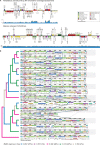Plastome Reduction in the Only Parasitic Gymnosperm Parasitaxus Is Due to Losses of Photosynthesis but Not Housekeeping Genes and Apparently Involves the Secondary Gain of a Large Inverted Repeat
- PMID: 31504501
- PMCID: PMC6786476
- DOI: 10.1093/gbe/evz187
Plastome Reduction in the Only Parasitic Gymnosperm Parasitaxus Is Due to Losses of Photosynthesis but Not Housekeeping Genes and Apparently Involves the Secondary Gain of a Large Inverted Repeat
Abstract
Plastid genomes (plastomes) of parasitic plants undergo dramatic reductions as the need for photosynthesis relaxes. Here, we report the plastome of the only known heterotrophic gymnosperm Parasitaxus usta (Podocarpaceae). With 68 unique genes, of which 33 encode proteins, 31 tRNAs, and four rRNAs in a plastome of 85.3-kb length, Parasitaxus has both the smallest and the functionally least capable plastid genome of gymnosperms. Although the heterotroph retains chlorophyll, all genes for photosynthesis are physically or functionally lost, making photosynthetic energy gain impossible. The pseudogenization of the three plastome-encoded light-independent chlorophyll biosynthesis genes chlB, chlL, and chlN implies that Parasitaxus relies on either only the light-dependent chlorophyll biosynthesis pathway or another regulation system. Nesting within a group of gymnosperms known for the absence of the large inverted repeat regions (IRs), another unusual feature of the Parasitaxus plastome is the existence of a 9,256-bp long IR. Its short length and a gene composition that completely differs from those of IR-containing gymnosperms together suggest a regain of this critical, plastome structure-stabilizing feature. In sum, our findings highlight the particular path of lifestyle-associated reductive plastome evolution, where structural features might provide additional cues of a continued selection for plastome maintenance.
Keywords: Parasitaxus; gene loss; mycoheterotrophy; parasitism; plastome.
© The Author(s) 2019. Published by Oxford University Press on behalf of the Society for Molecular Biology and Evolution.
Figures


Similar articles
-
The loss of photosynthetic pathways in the plastid and nuclear genomes of the non-photosynthetic mycoheterotrophic eudicot Monotropa hypopitys.BMC Plant Biol. 2016 Nov 16;16(Suppl 3):238. doi: 10.1186/s12870-016-0929-7. BMC Plant Biol. 2016. PMID: 28105941 Free PMC article.
-
The dynamic history of gymnosperm plastomes: Insights from structural characterization, comparative analysis, phylogenomics, and time divergence.Plant Genome. 2021 Nov;14(3):e20130. doi: 10.1002/tpg2.20130. Epub 2021 Sep 10. Plant Genome. 2021. PMID: 34505399
-
Evolutionary Stasis in Cycad Plastomes and the First Case of Plastome GC-Biased Gene Conversion.Genome Biol Evol. 2015 Jun 27;7(7):2000-9. doi: 10.1093/gbe/evv125. Genome Biol Evol. 2015. PMID: 26116919 Free PMC article.
-
Plastomes on the edge: the evolutionary breakdown of mycoheterotroph plastid genomes.New Phytol. 2017 Apr;214(1):48-55. doi: 10.1111/nph.14398. Epub 2017 Jan 9. New Phytol. 2017. PMID: 28067952 Review.
-
Piecing together the puzzle of parasitic plant plastome evolution.Planta. 2011 Oct;234(4):647-56. doi: 10.1007/s00425-011-1494-9. Epub 2011 Aug 18. Planta. 2011. PMID: 21850456 Review.
Cited by
-
Genomic reconfiguration in parasitic plants involves considerable gene losses alongside global genome size inflation and gene births.Plant Physiol. 2021 Jul 6;186(3):1412-1423. doi: 10.1093/plphys/kiab192. Plant Physiol. 2021. PMID: 33909907 Free PMC article.
-
Plastid phylogenomics reveals evolutionary relationships in the mycoheterotrophic orchid genus Dipodium and provides insights into plastid gene degeneration.Front Plant Sci. 2024 Jun 13;15:1388537. doi: 10.3389/fpls.2024.1388537. eCollection 2024. Front Plant Sci. 2024. PMID: 38938632 Free PMC article.
-
Comparative Analyses of 3,654 Plastid Genomes Unravel Insights Into Evolutionary Dynamics and Phylogenetic Discordance of Green Plants.Front Plant Sci. 2022 Apr 11;13:808156. doi: 10.3389/fpls.2022.808156. eCollection 2022. Front Plant Sci. 2022. PMID: 35498716 Free PMC article.
-
Plastid phylogenomics uncovers multiple species in Medicago truncatula (Fabaceae) germplasm accessions.Sci Rep. 2022 Dec 7;12(1):21172. doi: 10.1038/s41598-022-25381-1. Sci Rep. 2022. PMID: 36477422 Free PMC article.
-
Characterization and phylogenetic analysis of the complete chloroplast genome of Amaranthus viridis (Amaranthaceae).Mitochondrial DNA B Resour. 2021 Aug 9;6(9):2610-2612. doi: 10.1080/23802359.2021.1961631. eCollection 2021. Mitochondrial DNA B Resour. 2021. PMID: 34395893 Free PMC article.
References
-
- Barrett CF, et al. 2014. Investigating the path of plastid genome degradation in an early-transitional clade of heterotrophic orchids, and implications for heterotrophic angiosperms. Mol Biol Evol. 31(12):3095–3112. - PubMed
-
- Chaw S-M, Wu C-S, Sudianto E. 2018. Evolution of gymnosperm plastid genomes. In: Chaw S-M, Jansen RK, editors. Advances in botanical research. Cambridge, Massachusetts, USA: Academic Press. pp 195–222.
Publication types
MeSH terms
LinkOut - more resources
Full Text Sources

